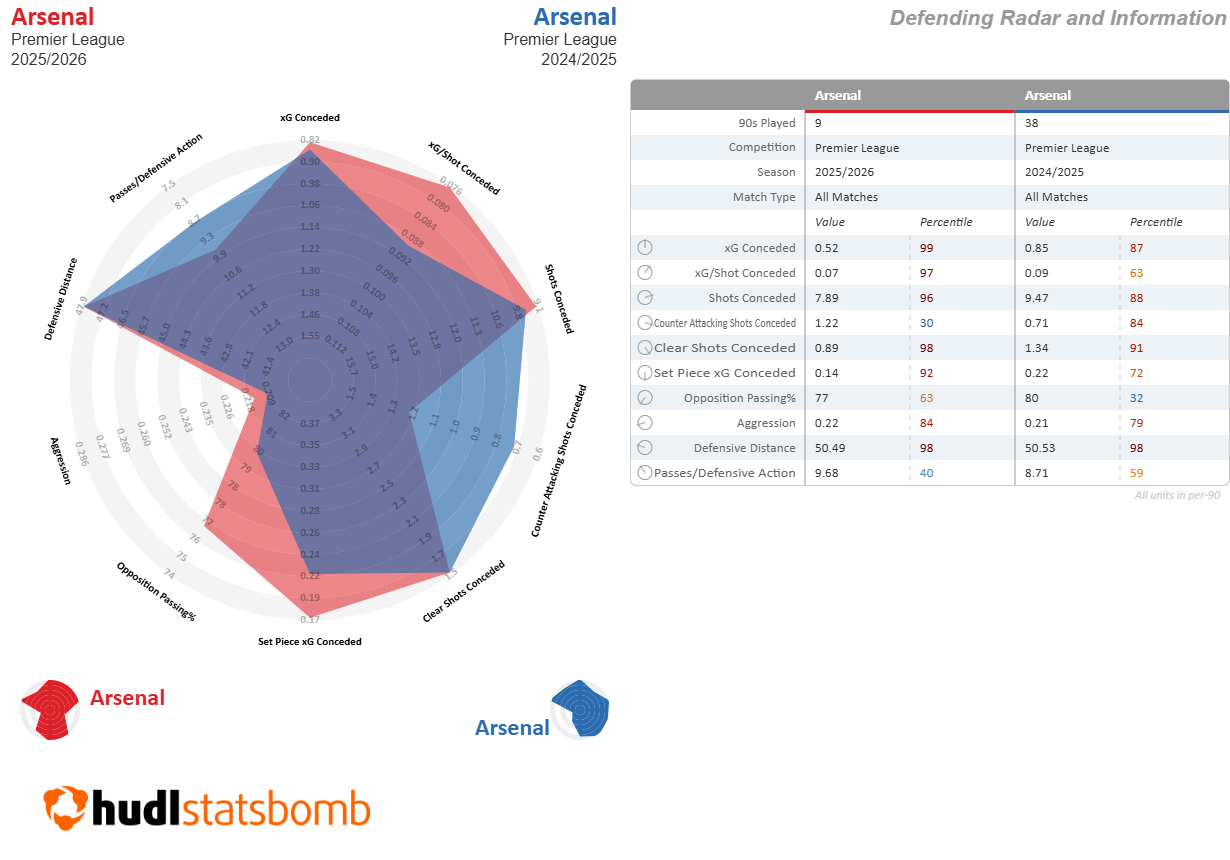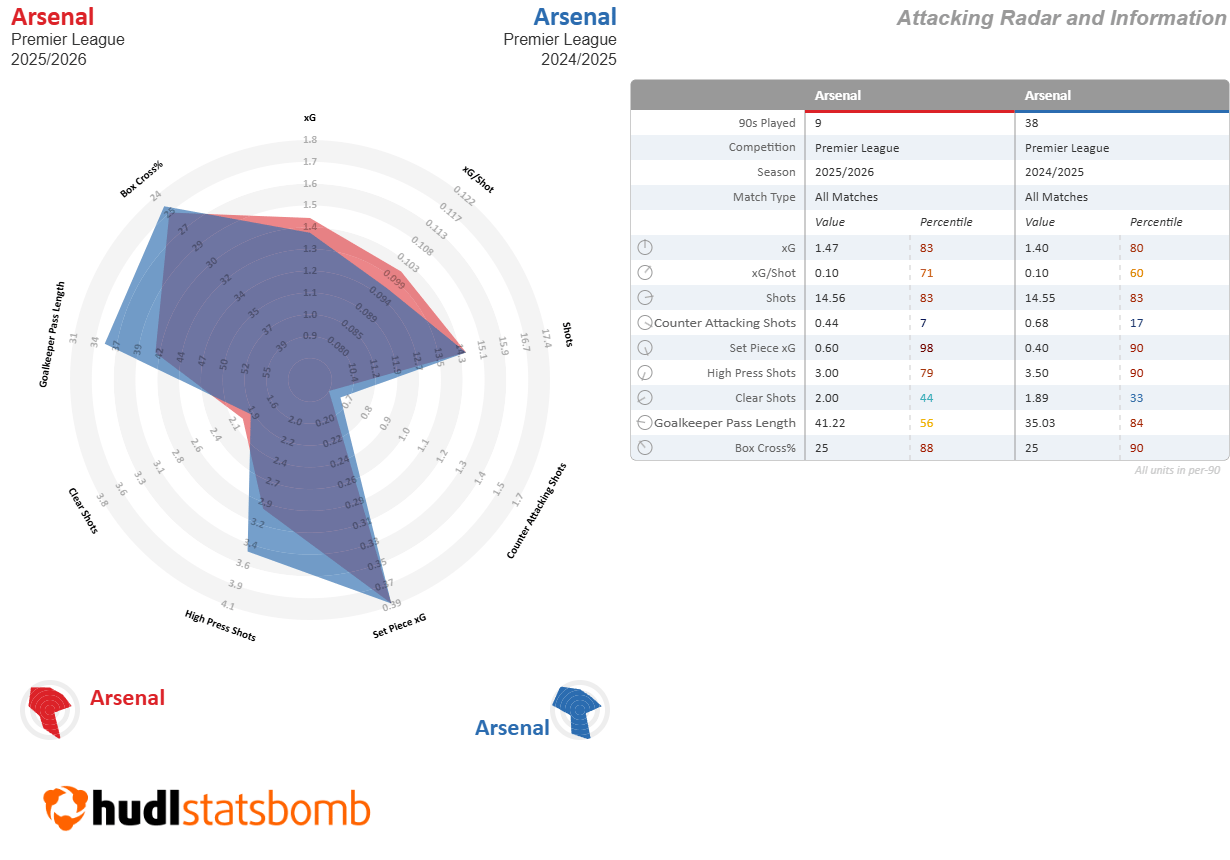- The Transfer Flow
- Posts
- You may not like Arsenal, but this is what peak performance looks like
You may not like Arsenal, but this is what peak performance looks like
Arsenal are now four points clear at the top of the Premier League and certainly look like the best team in the division.
We aren’t even a quarter of the way through the 2025/26 Premier League season, but the leaders already look on course to run away at the top. Arsenal’s noteworthy advantage in the points tally as well as their mightily impressive performances have quickly made them the outright favourites for the title by pretty much all accounts. Opta Analyst, for instance, are currently estimating that the Gunners have a 67.34% chance of finally winning their first men’s league title in over two decades.
Last weekend went about as well as it could have for Mikel Arteta’s side. Liverpool deservedly lost to Brentford on Saturday night, and while the Emirates Stadium watched the home team come away with a hard-fought 1-0 win over Crystal Palace on Sunday, Manchester City lost to Aston Villa by the same scoreline. As a result, Bournemouth are presently furthest ahead in the chasing pack, while the remainder of the top four is populated by Tottenham and – most incredibly of all – Sunderland. City are fifth with a six-point deficit to the title favourites, while the defending champions are a further point and two places below. As we discussed on the podcast, no one but Arsenal is currently very good.
All three title race protagonists had big summer transfer windows, with a combined transfer spend of over £750 million However, each of their approaches had different intentions, as we extensively covered on The Transfer Flow. Liverpool splashed the most cash as they set about revamping their side by bringing in world-class talents, predominantly attackers on the younger side of the age curve. They certainly look frightening on paper and have done so on the pitch at times, but their quest for balance has continued and perhaps even led them in a somewhat wrong direction, as four consecutive league defeats suggest. Manchester City, meanwhile, also undertook quite a bit of upheaval as they aimed to avoid the issues they faced last season. They undoubtedly have improved in relative terms, but some issues continue to linger.
Arsenal were not planning for any dramatic overhaul, but they still spent quite a lot of money in a bid to add further dimensions to their side. One of the main issues that left them agonisingly short of the league title in recent seasons was their lack of flexibility and heavy reliance on certain individuals. Arteta and his coaching staff had developed a team that certainly could compete with the best of the best when at peak condition, but they were found lacking in the reserves. So, Arsenal went and added top-class depth in all departments this summer. Funnily enough, their title rivals went the other way in certain respects – Liverpool are perhaps more reliant than ever on their starting centre-backs right now, while Manchester City’s goalscoring plan pretty much is Erling Haaland and inshallah.
So far, Arsenal’s approach is proving more than fruitful. Beyond their points tally and results, their performance and the surrounding context are a testament to that. Bukayo Saka, Martin Ødegaard and two recognised strikers have all been on the injury list for significant matches, yet the Gunners have managed to go about their business almost without skipping a beat. Even one of these absences might have derailed them in previous campaigns, but that is no longer the case. Noni Madueke now offers an excellent alternative option on the right wing, Eberechi Eze has been able to slot into the attacking midfield slot, and Viktor Gyökeres has largely done+ the dirty work well even if the goals haven’t been flowing for him.
Beyond the presence of these new backups, though, a large part of Arsenal’s success has to be attributed to further tactical development. For one, they have shown more flexibility in recent weeks, both in their structures and intentions. For instance, they quite clearly were looking to play forward quicker at St. James’ Park after baiting Newcastle’s press in the deep build-up. As a result, they managed to create some artificial transition situations rather than always gradually progressing through the thirds and coming up against a staunch low block. They couldn’t similarly bait Palace last weekend, but some structural tweaks helped make the difference. Most notably, it was left back Riccardo Calafiori who mostly stayed deep to form a back three, freeing up Jurrien Timber to some extent. This served two purposes – Calafiori was always present to limit Ismaïla Sarr’s threat on the counter, while Arsenal also focused their attacks down the right a little more and eventually broke through via that side.
I know I haven’t addressed the elephant in the room yet, and the last couple of examples will surely have reminded most readers of it. Yes, Arsenal won both of those matches thanks to set pieces. Yes, nine of their 14 non-penalty goals this season have come from such situations. Yes, you are free to consider them football terrorists as a result. But most importantly, this arguably makes them a better team.
Perhaps the most critical improvement Arsenal have made over the summer has been raising their floor to an even higher level. For one, their defence has somehow gotten even better, having conceded a grand total of three goals in nine games with the lowest xG conceded tally in the league by quite some margin. Most notably, they have improved by conceding fewer counterattacking shots, partly thanks to their increased structural flexibility.

But even more importantly, the Gunners have also raised the floor of their attack by becoming even more unstoppable with set-pieces. As Ted has noted many times including in the season previews, Arsenal’s inability to edge out wins in tight games was one of the main reasons behind their defeat in last season’s title race. Their tally of 14 draws was the highest among teams that finished in the top half of the table, and joint second-highest in the league. In pretty much all of those games, it was a lack of cutting edge in attack that caused frustration in North London.
Arsenal haven’t really made big strides forward in open play this season, but in the wise words of Hayden Van Brewer, “What is possession if not a way to win set pieces?”

We are now at a point in the season where the sample size is just about getting big enough to start drawing some conclusions in certain cases, but it is always worthwhile to make more like-for-like comparisons. In Arsenal’s case, such an approach shows an even bigger improvement:
Arsenal Compared to Corresponding Fixtures Last Season Points: +9 (22 vs 13) xG: -1.2 (14.9 vs 16.1) G: -2 (16 vs 18) xGA: -3.6 (5.2 vs 8.8) GA: -8.0 (3 vs 11) xG Dif: +2.4 (9.7 vs 7.3) G Dif: +6 (13 vs 7)
— Scott Willis (@scott.cannonstats.com)2025-10-26T18:07:04.941Z
Arsenal had dropped points in all the corresponding away fixtures last season, having drawn with Fulham, Manchester United and Liverpool besides losing to Newcastle. Additionally, they lost at home against West Ham and only managed a draw when hosting Crystal Palace.
So, where does the difference lie? For one, the defence looks a whole lot better in this set of games, shooting up from just one clean sheet to six so far this term. At the other end, Arsenal’s xG tally shows a slight drop (for which game state has to be considered a factor), but they have gone up from 48 to 54 set-piece shots. Over a quarter of the tally last season came from the 5-1 beatdown of Leicester City, but the corresponding fixture this term (the 5-0 win over Leeds United) only had six. Most importantly of all, the set-piece goals figure has tripled from three to nine, and that’s what’s helped convert those draws into wins.
Most importantly of all, Arsenal’s prolific record from set-pieces this season does not appear overly unsustainable. Their return of one set-piece goal per game is some way above their average of 0.6 xG from such situations every game, but even the latter stat shows a significant improvement from 0.4 last term. Their set-piece shots per game figure has gone up from 4 to 5.44, while their set-piece to goals conversion rate has jumped from 1% to 3%. Needless to say, the Gunners are now by far the best in the league in all these metrics.
Perhaps surprisingly, the number of set-piece situations Arsenal are getting has basically remained unchanged at just below the league average, and they aren’t even making the most of all types of dead-ball scenarios. Their indirect free-kicks have been good enough and yielded a couple of goals, and they are riding high on corners with seven goals out of 67. However, the Gunners are as low as 16th for shots from corners with just 13, and while the high-risk-high-reward nature of their approach and in-swinging deliveries has to be factored in, there surely is room for improvement in this respect. On top of all that, they haven’t even properly gotten in on the act as far as long throws are concerned!
While Arsenal are running hot with their set-piece conversion, these numbers clearly show that they have the scope to increase the efficiency of their chance creation from dead balls. So, their current set-piece goals return should at least be sustainable, if not even improvable. Add to that the return of some injured stars along with a potential willingness to adopt a more attacking structure in certain cases (as the Atlético Madrid match seemed to suggest), and the only way for this team might just be up.
One could go as far as to argue that this Arsenal team is comparable to peak Manchester City. Both sides were/are absolutely elite at controlling games (City with possession, Arsenal thanks to their incredibly solid defence) and both could/can break down any defence (City with their irresistible attacking firepower, Arsenal often with set-pieces).
You may not like it, but this is what peak performance looks like.
If you enjoyed this newsletter, we’d appreciate it if you would forward it to a friend. If you’re that friend, welcome! You can subscribe to The Transfer Flow here. We also have a podcast where we go in depth on transfer news and rumours every week. We’re on YouTube here, and you can subscribe on Apple Podcasts or Spotify by searching for “The Transfer Flow Podcast.” If you’re interested in football betting, check out this post on why we started Variance Betting.